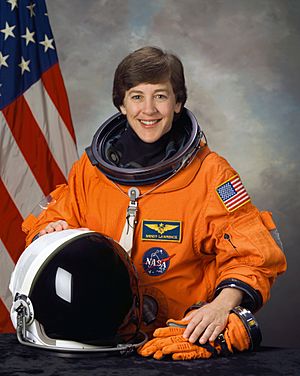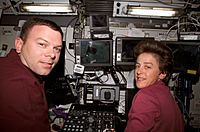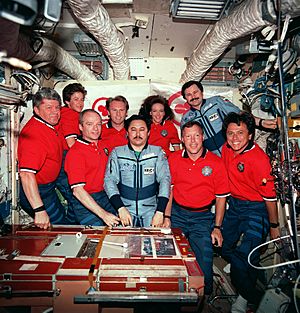Wendy B. Lawrence facts for kids
Quick facts for kids
Wendy Lawrence
|
|
|---|---|
 |
|
| Born |
Wendy Barrien Lawrence
July 2, 1959 Jacksonville, Florida, U.S.
|
| Space career | |
| NASA astronaut | |
| Rank | Captain, USN (ret.) |
|
Time in space
|
51d 3h 56m |
| Selection | NASA Group 14 (1992) |
| Missions | STS-67 STS-86 STS-91 STS-114 |
|
Mission insignia
|
|
Wendy Barrien Lawrence, born on July 2, 1959, is an amazing American who was a Captain in the United States Navy. She is also an engineer, a helicopter pilot, and a former astronaut for NASA. Wendy Lawrence made history as the first woman to graduate from the United States Naval Academy and then fly into space! She even visited the Russian Space Station Mir. She was a key crew member on STS-114, which was the first Space Shuttle flight after the Space Shuttle Columbia accident. She is married to Cathy Watson, a former NASA scientist.
Contents
Early Life and Family
Wendy Lawrence was born in Jacksonville, Florida. Her family has a strong history in aviation. Both her father and grandfather were pilots in the Navy. Her grandfather was a well-known student-athlete named Fatty Lawrence. Her father, William P. Lawrence, was a Vice Admiral. He was also a finalist for the Project Mercury astronaut program and was a Vietnam War prisoner of war. He later became the leader of the U.S. Naval Academy. A Navy ship, the USS William P. Lawrence (DDG-110), is named after him.
Education and Learning
Wendy Lawrence finished high school at Fort Hunt High School in Alexandria, Virginia, in 1977. She then attended the U.S. Naval Academy. In 1981, she earned a Bachelor of Science degree in Ocean Engineering. She continued her studies and received a Master of Science degree in Ocean Engineering in 1988. She earned this degree from a special program between the Massachusetts Institute of Technology and the Woods Hole Oceanographic Institution.
Military Career
After graduating from the U.S. Naval Academy in 1981, Wendy Lawrence became a Naval Aviator (a Navy pilot) in July 1982. She was a very skilled pilot. She has flown helicopters for more than 1,500 hours. She also landed helicopters on ships over 800 times.
While working with Helicopter Combat Support Squadron 6, she was one of the first two female helicopter pilots to go on a long trip to the Indian Ocean. This trip was part of a large group of Navy ships. After getting her master's degree in 1988, she worked as an officer in charge of a helicopter unit. In October 1990, Lawrence returned to the U.S. Naval Academy. There, she taught physics and coached the new women's crew team.
NASA Career
NASA chose Wendy Lawrence to become an astronaut in March 1992. She started her training at the Johnson Space Center in August 1992. After a year of training, she became qualified as a mission specialist. This meant she could fly on space missions.
She worked on checking flight software and helped train other astronauts. She also helped with training and support for the Space Station crews. Her first space flight was on STS-67 from March 2 to March 18, 1995. On this mission, she was the flight engineer during launch and landing.
Later, she worked as the Director of Operations for NASA in Star City, Russia. Her job was to help coordinate space mission activities in Russia for the joint U.S./Russian Shuttle/Mir program. In September 1996, she began training for a four-month mission on the Russian Space Station Mir. However, she was replaced by David Wolf because the Russian Orlan spacesuits were too big for her.
Because she knew so much about the Mir station and how to transfer crews, she flew on two more missions to Mir: STS-86 (September 25 to October 6, 1997) and STS-91 (June 2 to June 12, 1998).
Captain Lawrence has flown on four space missions. She has spent over 1,200 hours, which is more than 50 days, in space! Her last mission was STS-114. On this flight, she was in charge of moving supplies and equipment. She also operated the Space Station's robotic arm. This mission was very important because it was the first "Return to Flight" mission after the Space Shuttle Columbia accident. The crew tested new ways to check and fix the Space Shuttle's heat shield. The mission launched on July 26, 2005, and landed on August 9, 2005.
Captain Lawrence retired from NASA in June 2006.
Spaceflight Missions

- STS-67 (March 2–18, 1995): This mission used the ASTRO observatory, which had three special telescopes. The crew studied faint objects in space and the light from hot stars and distant galaxies. The mission lasted for 16 days.
- STS-86 (September 25 to October 6, 1997): This was the seventh time a Space Shuttle connected with the Russian Space Station Mir. During this mission, U.S. astronauts Mike Foale and David Wolf swapped places. Astronauts also did a spacewalk to get experiments that were left outside Mir. The crew transferred over 10,000 pounds of supplies to Mir and brought back experiment results to Earth.
- STS-91 (June 2–12, 1998): This was the ninth and final mission where a Space Shuttle connected with Mir. It marked the end of the joint U.S./Russian Phase I Program.
- STS-114 (July 26 – August 9, 2005): This was the first "Return to Flight" mission after the Space Shuttle Columbia accident. A major part of this mission was the first-ever repair of the orbiter while it was in space, done during a spacewalk.
Awards and Honors
Wendy Lawrence has received many awards for her service and achievements:
 |
||
| Naval Aviator Astronaut badge | ||
| Defense Superior Service Medal with cluster |
||
| Legion of Merit | Defense Meritorious Service Medal with two clusters |
Meritorious Service Medal with star |
| Achievement Medal with star |
NASA Space Flight Medal with three stars |
National Defense Service Medal with star |
| Global War on Terrorism Service Medal |
Sea Service Deployment Ribbon with star |
Overseas Service Ribbon |
| Winifred Collins Award | ||
- In 2019, she received the U.S. Naval Academy Distinguished Graduate Award. Her father also received this special award in 2000.
See also
 In Spanish: Wendy B. Lawrence para niños
In Spanish: Wendy B. Lawrence para niños



